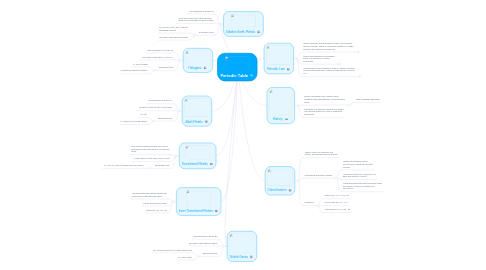
1. Transitional Metals
1.1. The Group B elements that are usually displayed in the main body of a periodic table.
1.2. In the center of the table, aka D block
1.3. Examples/Uses
1.3.1. Cu, Ag, Au, used in things such as jewelry.
2. Inner Transitional Metals
2.1. The elements that appear below the main body of the periodic table.
2.2. Below the periodic table
2.3. Examples: Dy, No, Ce
3. Alkali Metals
3.1. The elements in group 1a.
3.2. Located on the far left of the table.
3.3. Examples/Uses
3.3.1. Na, salt
3.3.2. K, nutrients for living things
4. Alkaline Earth Metals
4.1. The elements in group 2a.
4.2. They are on the left of the periodic table but on the right of alkali metals.
4.3. Examples/Uses
4.3.1. Ca, found in milk, etc., helps to strengthen bones.
4.3.2. Mg, helps with photosynthesis
5. Halogens
5.1. The nonmetals of group 7a.
5.2. The right of the table, column 17.
5.3. Examples/Uses
5.3.1. Cl, pool cleaner
5.3.2. F, high-temperature plastics.
6. Noble Gases
6.1. The elements in group 8a
6.2. Far right of the periodic table.
6.3. Examples/Uses
6.3.1. He, filling up balloons to make them float
6.3.2. Ne, neon signs
7. Periodic Law
7.1. When elements are arranged in order of increasing atomic number, there is a periodic repetition of their physical and chemical properties.
7.1.1. Task
7.1.2. Prerequisites
7.2. When the elements are arranged there is a repetition of their properties.
7.2.1. Task
7.2.2. Prerequisites
7.3. The elements are arranged in order of atomic number, starting with hydrogen, which has the atomic number of 1.
7.3.1. Task
7.3.2. Prerequisites
8. Classification
8.1. Three classes of elements are metals, nonmentals and metalloids.
8.2. Comparing the three classes
8.2.1. Metals are generally good conductors of heat and electric current.
8.2.2. Nonmetals are poor conductors of heat and electric current.
8.2.3. Metalloids generally have properties that are similar to those of metals and nonmetals.
8.3. Examples
8.3.1. Metals-ex.: Cu, Al, Fe, Mg
8.3.2. Nonmetals-ex:H, O, C, N
8.3.3. Metalloids-ex.: B, Si, At, Ge
9. History
9.1. Dmitri Mendeleev and Lothar Meyer impacted the development of the periodic table.
9.1.1. They published the table.
